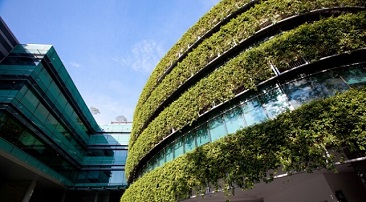 Architects, designers, and contractors are now commonly engaged in new construction, renovation and redesign projects intended to have smallest environmental and climate footprint possible. The factors that contribute to “green buildings” are fairly intuitive: energy efficiency and alternative energy sources, reduced water consumption, utilization of recycled materials, and low-emitting building materials and maintenance products. Building codes, owner specifications, and market demand are driving this trend around the world.
Architects, designers, and contractors are now commonly engaged in new construction, renovation and redesign projects intended to have smallest environmental and climate footprint possible. The factors that contribute to “green buildings” are fairly intuitive: energy efficiency and alternative energy sources, reduced water consumption, utilization of recycled materials, and low-emitting building materials and maintenance products. Building codes, owner specifications, and market demand are driving this trend around the world.
One of the cornerstones of this movement is the push for “healthy buildings,” addressing occupant health, comfort, and wellness. After all, the building’s primary function is to serve its occupants’ needs. As one would expect, it’s the details that matter. Fortunately, there are multiple rating systems and certifications available to help.
For example, the WELL Building Standard focuses on designing spaces where occupants can thrive. Both the U.S. Green Building Council’s Leadership in Environmental and Energy Design (LEED v4) initiative and the European-based BREEAM sustainability assessment system actively encourage material transparency, indoor environmental quality, and use of healthy building materials (e.g., the LEED v4 MR credit for Building Product Disclosure and Optimization – Material Ingredients). Product certification programs, such as SCS Global Service’s Indoor Advantage indoor air quality standard and the Resilient Floor Covering Institute’s FloorScore program, provide detailed criteria and auditing requirements for a wide range of building materials, paints and coatings, furniture, and flooring products, which in turn lead to eligibility for recognition under a multitude of green building platforms. The Health Product Declaration (HPD) Collaborative helps drive product transparency with its third-party verified HPDs, which can be used to meet LEED v4 MR, Google’s Healthy Building Program and Portico listing, and the Living Product Challenge for Net Positive Material Health Imperative. The International Living Future Institute’s (ILFI) Living Building Challenge includes the use of healthy materials among its key criteria for eligibility in the Declare labeling database. And the list goes on.
Indeed, with so many options to consider, it is also helpful that the U.S. Environmental Protection Agency has qualified many of these programs under its Recommendations of Specifications, Standards, and Ecolabels for Federal Purchasing.
There are substantial benefits to supporting healthy spaces. As described in last fall’s “What You Can’t See Can Hurt You: Improving the Air We Breathe Indoors,” a study conducted by Harvard University and SUNY Upstate found that cognitive function and performance were substantially higher for individuals in green buildings compared to conventional ones. Some of the activities tested included information usage, crisis response, and focused activity level.
Interest in greater transparency is coming not just from building occupants, owners and designers, but from manufacturers themselves. For instance, PLAE, Bentley Mills, and Sloan are just some of the companies utilizing their own certification efforts to gain further insight into their material suppliers and the associated health impacts of product ingredients, to identify opportunities to improve, reduce, or eliminate ingredients of concern.
Lingering Problems & Solutions
Even as the demand for green buildings grows, conventional buildings still make up a large portion of the current stock. Unfortunately, such buildings are often detrimental to the health of people who live and work in them. While ambient air pollution is a serious health concern around the world, indoor air is often even more polluted. Contaminants can more easily accumulate inside buildings, compounding internal air quality and health issues. One of the most common problems, Sick Building Syndrome, is directly attributed to indoor environmental quality. Occupants suffering from the syndrome often display a variety of non-specific symptoms, including headaches, cold and flu-like symptoms, allergies, asthma attacks, dizziness and nausea. This leads to decreased employee productivity.
Here are a few key sources of pollution to be aware of:
- Lingering toxic building materials—Older buildings that have not previously undergone renovation may contain materials now deemed carcinogenic or otherwise toxic. Both asbestos and lead were widely incorporated into building materials in previous decades and can still be found in structures today. If a building contains one of these toxins, exposure could occur during routine building maintenance, during the renovation process, or simply as old materials degrade. For instance, a Reuters investigation in late 2016 found blood levels of lead in children in 3,000 communities across the United States to be up to four times higher than those in the widely-publicized lead poisoning scandal in Flint, Mich. In many cases, this contamination has been linked to old housing stock, schools, and other buildings in which aging lead-based paints have weathered and old plumbing fixtures have remained in use. Businesses and building owners must recognize that if employees or other occupants inhale asbestos fibers or lead dust, serious health concerns may develop years later, including cancers such as mesothelioma or neurological deficits, respectively. Toxins of this nature require immediate professional attention to mitigate their severe health risks.
- Off-gassing from interior products—Sometimes everyday products and materials found or used inside buildings and homes can emit chemicals into the air. Cleaning products, new furniture, flooring and more can all release pollutants into the air through a process called off-gassing. The chemicals produced during this process include volatile organic compounds (VOCs), which can cause everything from mild irritation to cancer. Two VOCs commonly found inside buildings are benzene and formaldehyde, both of which are considered human carcinogens. Adequate ventilation is one of the keys to reducing the risk of product off-gassing in the home or office.Even more proactively, businesses and homeowners can now choose from a wide range of “low-emitting” products that don’t contain such harsh chemicals. SCS’ Certified Green Products Guide lists nearly 5,000 products that meet stringent indoor air quality standards under its Indoor Advantage program alone, and thousands more that comply with other standards minimizing VOC off-gassing. Manufacturers such as Herman Miller, Steelcase, Humanscale, and KI not only have had their products independently verified but have used VOC emission test results to learn how to further enhance performance while decreasing VOC emissions even more—that is, leveraging data to make informed decisions from product design to component purchasing.
- Biological contaminants—Buildings that do not properly regulate moisture levels, air circulation, and ventilation are likely to have biological pollutants present in the indoor environment. As described by the S. EPA, these organisms include mold, fungi, pollen, and bacteria, which can either grow within the building itself or be introduced from outside through the building’s ventilation system. Reducing this risk requires being mindful of moisture build-up and regularly inspecting air intake points for cleanliness. Microscopic contaminants make it impossible to identify poor air quality with the naked eye, but their effects are nonetheless pronounced.
Unfortunately, many conventional buildings are not able to provide healthy spaces for the individuals that utilize them. This is where comprehensive and holistic building certifications come into play to ensure optimal indoor environmental conditions.
As aging infrastructure is updated to reflect more sustainable values, the impact of toxic materials and pollutants in our spaces will continue to be addressed. These actions, combined with rigorous new building standards and the growth in demand for green buildings, will help to ensure that our towns and cities become more sustainable and healthy over time.
Anna Suarez is Communications Specialist with the Mesothelioma and Asbestos Awareness Center. She can be contacted at asuarez@maacenter.org. Nicole Muñoz is Managing Director for Environmental Certification Services for SCS Global Services. She can be reached at nmunoz@scsglobalservices.com, or (510) 452.8031.





